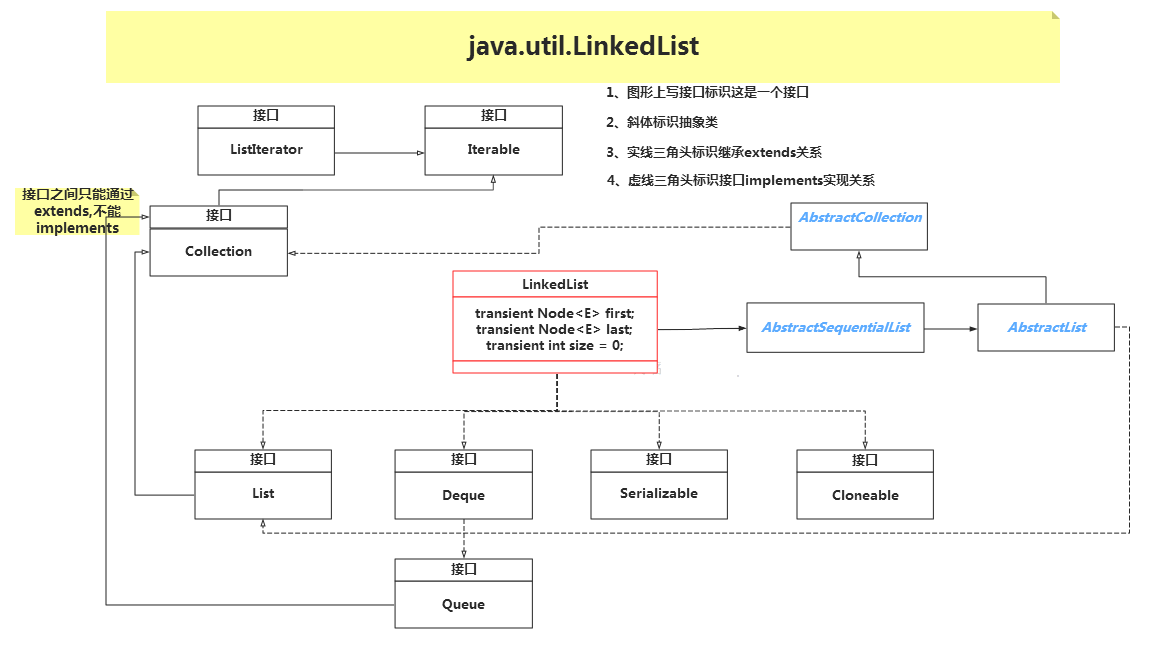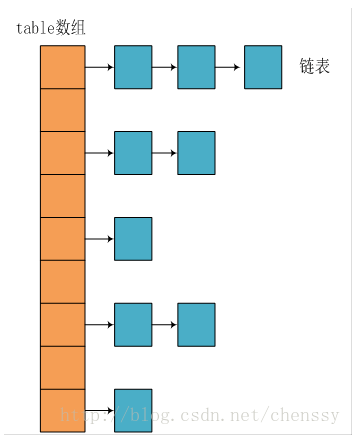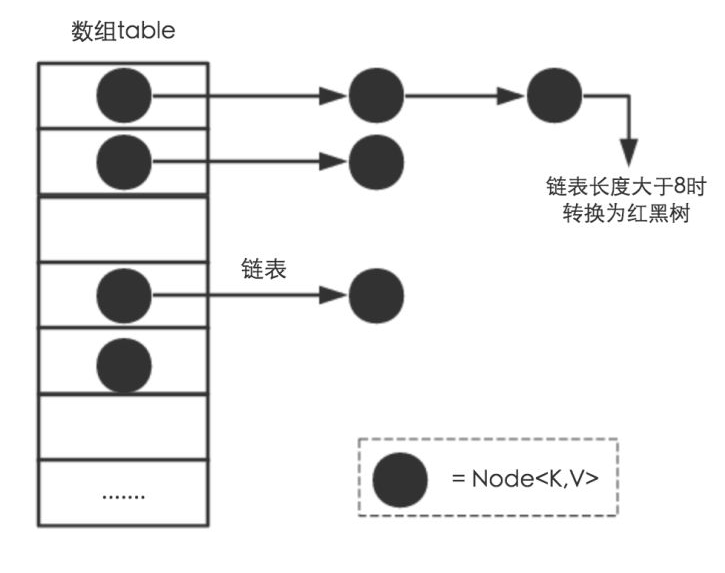问题导读:
1、LinkedList的定义是什么?
2、LinkedList元素的处理方法有哪些?
3、HashMap底层数据结构是什么样?
4、HashMap方法都有哪些?
Java高级特性增强-集合框架(LinkedList/HashMap)**
本部分网络上有大量的资源可以参考,在这里做了部分整理,感谢前辈的付出,每节文章末尾有引用列表,源码推荐看JDK1.8以后的版本,注意甄别~ ####多线程 ###集合框架 ###NIO ###Java并发容器
集合框架
Java中的集合框架
ArrayList/Vector LinkedList HashMap HashSet LinkedHashMap … 本章内容参考引用网上的内容为主,网上有大量优质的资源,作者在这里做了整理如下:
LinkedList(基于JDK1.8)LinkedList 定义
LinkedList 是一个用链表实现的集合,元素有序且可以重复。
public class LinkedList<E>extends AbstractSequentialList<E>implements List<E>, Deque<E>, Cloneable, java.io.Serializable

和 ArrayList 集合一样,LinkedList 集合也实现了Cloneable接口和Serializable接口,分别用来支持克隆以及支持序列化。List 接口也不用多说,定义了一套 List 集合类型的方法规范。注意,相对于 ArrayList 集合,LinkedList 集合多实现了一个 Deque 接口,这是一个双向队列接口,双向队列就是两端都可以进行增加和删除操作。
字段属性
//链表元素(节点)的个数transient int size = 0;/***指向第一个节点的指针*/transient Node<E> first;/***指向最后一个节点的指针*/transient Node<E> last;
注意这里出现了一个 Node 类,这是 LinkedList 类中的一个内部类,其中每一个元素就代表一个 Node 类对象,LinkedList 集合就是由许多个 Node 对象类似于手拉着手构成。
private static class Node<E> {E item;//实际存储的元素Node<E> next;//指向上一个节点的引用Node<E> prev;//指向下一个节点的引用//构造函数Node(Node<E> prev, E element, Node<E> next) {this.item = element;this.next = next;this.prev = prev;}}
如下图所示:
上图的 LinkedList 是有四个元素,也就是由 4 个 Node 对象组成,size=4,head 指向第一个elementA,tail指向最后一个节点elementD。
构造函数
public LinkedList() {}public LinkedList(Collection<? extends E> c) {this();addAll(c);}
LinkedList 有两个构造函数,第一个是默认的空的构造函数,第二个是将已有元素的集合Collection 的实例添加到 LinkedList 中,调用的是 addAll() 方法,这个方法下面我们会介绍。 注意:LinkedList 是没有初始化链表大小的构造函数,因为链表不像数组,一个定义好的数组是必须要有确定的大小,然后去分配内存空间,而链表不一样,它没有确定的大小,通过指针的移动来指向下一个内存地址的分配。
添加元素
addFirst(E e) 将指定元素添加到链表头
//将指定的元素附加到链表头节点public void addFirst(E e) {linkFirst(e);}private void linkFirst(E e) {final Node<E> f = first;//将头节点赋值给 ffinal Node<E> newNode = new Node<>(null, e, f);//将指定元素构造成一个新节点,此节点的指向下一个节点的引用为头节点first = newNode;//将新节点设为头节点,那么原先的头节点 f 变为第二个节点if (f == null)//如果第二个节点为空,也就是原先链表是空last = newNode;//将这个新节点也设为尾节点(前面已经设为头节点了)elsef.prev = newNode;//将原先的头节点的上一个节点指向新节点size++;//节点数加1modCount++;//和ArrayList中一样,iterator和listIterator方法返回的迭代器和列表迭代器实现使用。}
addLast(E e)和add(E e) 将指定元素添加到链表尾
//将元素添加到链表末尾public void addLast(E e) {linkLast(e);}//将元素添加到链表末尾public boolean add(E e) {linkLast(e);return true;}void linkLast(E e) {final Node<E> l = last;//将l设为尾节点final Node<E> newNode = new Node<>(l, e, null);//构造一个新节点,节点上一个节点引用指向尾节点llast = newNode;//将尾节点设为创建的新节点if (l == null)//如果尾节点为空,表示原先链表为空first = newNode;//将头节点设为新创建的节点(尾节点也是新创建的节点)elsel.next = newNode;//将原来尾节点下一个节点的引用指向新节点size++;//节点数加1modCount++;//和ArrayList中一样,iterator和listIterator方法返回的迭代器和列表迭代器实现使用。}
addAll(Collection<? extends E> c) 按照指定集合的迭代器返回的顺序,将指定集合中的所有元素追加到此列表的末尾
此方法还有一个 addAll(int index, Collection<? extends E> c),将集合 c 中所有元素插入到指定索引的位置。其实 addAll(Collection<? extends E> c) == addAll(size, Collection<? extends E> c)
删除元素
删除元素和添加元素一样,也是通过更改指向上一个节点和指向下一个节点的引用即可. remove()和removeFirst() 从此列表中移除并返回第一个元素 removeLast() 从该列表中删除并返回最后一个元素 remove(int index) 删除此列表中指定位置的元素 remove(Object o) 如果存在,则从该列表中删除指定元素的第一次出现 此方法本质上和 remove(int index) 没多大区别,通过循环判断元素进行删除,需要注意的是,是删除第一次出现的元素,不是所有的。
修改元素
通过调用 set(int index, E element) 方法,用指定的元素替换此列表中指定位置的元素。
public E set(int index, E element) {//判断索引 index >= 0 && index <= size中时抛出IndexOutOfBoundsException异常checkElementIndex(index);Node<E> x = node(index);//获取指定索引处的元素E oldVal = x.item;x.item = element;//将指定位置的元素替换成要修改的元素return oldVal;//返回指定索引位置原来的元素}
这里主要是通过 node(index) 方法获取指定索引位置的节点,然后修改此节点位置的元素即可。
查找元素
getFirst() 返回此列表中的第一个元素 getLast() 返回此列表中的最后一个元素 get(int index) 返回指定索引处的元素 indexOf(Object o) 返回此列表中指定元素第一次出现的索引,如果此列表不包含元素,则返回-1。
遍历集合
普通for循环
LinkedList<String> linkedList = new LinkedList<>();linkedList.add("A");linkedList.add("B");linkedList.add("C");linkedList.add("D");for(int i = 0 ; i < linkedList.size() ; i++){System.out.print(linkedList.get(i)+" ");//A B C D}
代码很简单,我们就利用 LinkedList 的 get(int index) 方法,遍历出所有的元素。 但是需要注意的是, get(int index) 方法每次都要遍历该索引之前的所有元素,这句话这么理解: 比如上面的一个 LinkedList 集合,我放入了 A,B,C,D是个元素。总共需要四次遍历: 第一次遍历打印 A:只需遍历一次。 第二次遍历打印 B:需要先找到 A,然后再找到 B 打印。 第三次遍历打印 C:需要先找到 A,然后找到 B,最后找到 C 打印。 第四次遍历打印 D:需要先找到 A,然后找到 B,然后找到 C,最后找到 D。 这样如果集合元素很多,越查找到后面(当然此处的get方法进行了优化,查找前半部分从前面开始遍历,查找后半部分从后面开始遍历,但是需要的时间还是很多)花费的时间越多。那么如何改进呢?
迭代器
**
LinkedList<String> linkedList = new LinkedList<>();linkedList.add("A");linkedList.add("B");linkedList.add("C");linkedList.add("D");Iterator<String> listIt = linkedList.listIterator();while(listIt.hasNext()){System.out.print(listIt.next()+" ");//A B C D}//通过适配器模式实现的接口,作用是倒叙打印链表Iterator<String> it = linkedList.descendingIterator();while(it.hasNext()){System.out.print(it.next()+" ");//D C B A}
在 LinkedList 集合中也有一个内部类 ListItr,方法实现大体上也差不多,通过移动游标指向每一次要遍历的元素,不用在遍历某个元素之前都要从头开始。其方法实现也比较简单:
public ListIterator<E> listIterator(int index) {checkPositionIndex(index);return new ListItr(index);}private class ListItr implements ListIterator<E> {private Node<E> lastReturned;private Node<E> next;private int nextIndex;private int expectedModCount = modCount;ListItr(int index) {// assert isPositionIndex(index);next = (index == size) ? null : node(index);nextIndex = index;}public boolean hasNext() {return nextIndex < size;}public E next() {checkForComodification();if (!hasNext())throw new NoSuchElementException();lastReturned = next;next = next.next;nextIndex++;return lastReturned.item;}public boolean hasPrevious() {return nextIndex > 0;}public E previous() {checkForComodification();if (!hasPrevious())throw new NoSuchElementException();lastReturned = next = (next == null) ? last : next.prev;nextIndex--;return lastReturned.item;}public int nextIndex() {return nextIndex;}public int previousIndex() {return nextIndex - 1;}public void remove() {checkForComodification();if (lastReturned == null)throw new IllegalStateException();Node<E> lastNext = lastReturned.next;unlink(lastReturned);if (next == lastReturned)next = lastNext;elsenextIndex--;lastReturned = null;expectedModCount++;}public void set(E e) {if (lastReturned == null)throw new IllegalStateException();checkForComodification();lastReturned.item = e;}public void add(E e) {checkForComodification();lastReturned = null;if (next == null)linkLast(e);elselinkBefore(e, next);nextIndex++;expectedModCount++;}public void forEachRemaining(Consumer<? super E> action) {Objects.requireNonNull(action);while (modCount == expectedModCount && nextIndex < size) {action.accept(next.item);lastReturned = next;next = next.next;nextIndex++;}checkForComodification();}final void checkForComodification() {if (modCount != expectedModCount)throw new ConcurrentModificationException();}}
这里需要重点注意的是 modCount 字段,前面我们在增加和删除元素的时候,都会进行自增操作 modCount,这是因为如果想一边迭代,一边用集合自带的方法进行删除或者新增操作,都会抛出异常。(使用迭代器的增删方法不会抛异常)
final void checkForComodification() {if (modCount != expectedModCount)throw new ConcurrentModificationException();}
比如:
LinkedList<String> linkedList = new LinkedList<>();linkedList.add("A");linkedList.add("B");linkedList.add("C");linkedList.add("D");Iterator<String> listIt = linkedList.listIterator();while(listIt.hasNext()){System.out.print(listIt.next()+" ");//A B C D//linkedList.remove();//此处会抛出异常listIt.remove();//这样可以进行删除操作}
迭代器的另一种形式就是使用 foreach 循环,底层实现也是使用的迭代器.
LinkedList<String> linkedList = new LinkedList<>();linkedList.add("A");linkedList.add("B");linkedList.add("C");linkedList.add("D");for(String str : linkedList){System.out.print(str + "");}
HashMap(基于JDK1.8)
HashMap简介
HashMap 主要用来存放键值对,它基于哈希表的Map接口实现,是常用的Java集合之一。 JDK1.8 之前 HashMap 由 数组+链表 组成的,数组是 HashMap 的主体,链表则是主要为了解决哈希冲突而存在的(“拉链法”解决冲突).JDK1.8 以后在解决哈希冲突时有了较大的变化,当链表长度大于阈值(默认为 8)时,将链表转化为红黑树,以减少搜索时间。
底层数据结构分析
JDK1.8 之前 HashMap 底层是 数组和链表 结合在一起使用也就是 链表散列。HashMap 通过 key 的 hashCode 经过扰动函数处理过后得到 hash 值,然后通过 (n - 1) & hash 判断当前元素存放的位置(这里的 n 指的是数组的长度),如果当前位置存在元素的话,就判断该元素与要存入的元素的 hash 值以及 key 是否相同,如果相同的话,直接覆盖,不相同就通过拉链法解决冲突。 所谓扰动函数指的就是 HashMap 的 hash 方法。使用 hash 方法也就是扰动函数是为了防止一些实现比较差的 hashCode() 方法 换句话说使用扰动函数之后可以减少碰撞。 JDK 1.8 HashMap 的 hash 方法源码: JDK 1.8 的 hash方法 相比于 JDK 1.7 hash 方法更加简化,但是原理不变。
static final int hash(Object key) {int h;// key.hashCode():返回散列值也就是hashcode// ^ :按位异或// >>>:无符号右移,忽略符号位,空位都以0补齐return (key == null) ? 0 : (h = key.hashCode()) ^ (h >>> 16);}
对比一下 JDK1.7的 HashMap 的 hash 方法源码.
static int hash(int h) {// This function ensures that hashCodes that differ only by// constant multiples at each bit position have a bounded// number of collisions (approximately 8 at default load factor).h ^= (h >>> 20) ^ (h >>> 12);return h ^ (h >>> 7) ^ (h >>> 4);}
相比于 JDK1.8 的 hash 方法 ,JDK 1.7 的 hash 方法的性能会稍差一点点,因为毕竟扰动了 4 次。
所谓 “拉链法” 就是:将链表和数组相结合。也就是说创建一个链表数组,数组中每一格就是一个链表。若遇到哈希冲突,则将冲突的值加到链表中即可。
JDK1.8之后 相比于之前的版本,jdk1.8在解决哈希冲突时有了较大的变化,当链表长度大于阈值(默认为8)时,将链表转化为红黑树,以减少搜索时间。
类的属性:
public class HashMap<K,V> extends AbstractMap<K,V> implements Map<K,V>, Cloneable, Serializable {// 序列号private static final long serialVersionUID = 362498820763181265L;// 默认的初始容量是16static final int DEFAULT_INITIAL_CAPACITY = 1 << 4;// 最大容量static final int MAXIMUM_CAPACITY = 1 << 30;// 默认的填充因子static final float DEFAULT_LOAD_FACTOR = 0.75f;// 当桶(bucket)上的结点数大于这个值时会转成红黑树static final int TREEIFY_THRESHOLD = 8;// 当桶(bucket)上的结点数小于这个值时树转链表static final int UNTREEIFY_THRESHOLD = 6;// 桶中结构转化为红黑树对应的table的最小大小static final int MIN_TREEIFY_CAPACITY = 64;// 存储元素的数组,总是2的幂次倍transient Node<k,v>[] table;// 存放具体元素的集transient Set<map.entry<k,v>> entrySet;// 存放元素的个数,注意这个不等于数组的长度。transient int size;// 每次扩容和更改map结构的计数器transient int modCount;// 临界值 当实际大小(容量*填充因子)超过临界值时,会进行扩容int threshold;// 填充因子final float loadFactor;}
loadFactor加载因子
loadFactor加载因子是控制数组存放数据的疏密程度,loadFactor越趋近于1,那么 数组中存放的数据(entry)也就越多,也就越密,也就是会让链表的长度增加,load Factor越小,也就是趋近于0,
loadFactor太大导致查找元素效率低,太小导致数组的利用率低,存放的数据会很分散。loadFactor的默认值为0.75f是官方给出的一个比较好的临界值。
给定的默认容量为 16,负载因子为 0.75。Map 在使用过程中不断的往里面存放数据,当数量达到了 16 * 0.75 = 12 就需要将当前 16 的容量进行扩容,而扩容这个过程涉及到 rehash、复制数据等操作,所以非常消耗性能。
threshold
threshold = capacity * loadFactor,当Size>=threshold的时候,那么就要考虑对数组的扩增了,也就是说,这个的意思就是 衡量数组是否需要扩增的一个标准。
Node节点类源码:
// 继承自 Map.Entry<K,V>static class Node<K,V> implements Map.Entry<K,V> {final int hash;// 哈希值,存放元素到hashmap中时用来与其他元素hash值比较final K key;//键V value;//值// 指向下一个节点Node<K,V> next;Node(int hash, K key, V value, Node<K,V> next) {this.hash = hash;this.key = key;this.value = value;this.next = next;}public final K getKey() { return key; }public final V getValue() { return value; }public final String toString() { return key + "=" + value; }// 重写hashCode()方法public final int hashCode() {return Objects.hashCode(key) ^ Objects.hashCode(value);}public final V setValue(V newValue) {V oldValue = value;value = newValue;return oldValue;}// 重写 equals() 方法public final boolean equals(Object o) {if (o == this)return true;if (o instanceof Map.Entry) {Map.Entry<?,?> e = (Map.Entry<?,?>)o;if (Objects.equals(key, e.getKey()) &&Objects.equals(value, e.getValue()))return true;}return false;}}
树节点类源码:
static final class TreeNode<K,V> extends LinkedHashMap.Entry<K,V> {TreeNode<K,V> parent; // 父TreeNode<K,V> left; // 左TreeNode<K,V> right; // 右TreeNode<K,V> prev; // needed to unlink next upon deletionboolean red; // 判断颜色TreeNode(int hash, K key, V val, Node<K,V> next) {super(hash, key, val, next);}// 返回根节点final TreeNode<K,V> root() {for (TreeNode<K,V> r = this, p;;) {if ((p = r.parent) == null)return r;r = p;}
HashMap源码分析
构造方法
// 默认构造函数。public More ...HashMap() {this.loadFactor = DEFAULT_LOAD_FACTOR; // all other fields defaulted}// 包含另一个“Map”的构造函数public More ...HashMap(Map<? extends K, ? extends V> m) {this.loadFactor = DEFAULT_LOAD_FACTOR;putMapEntries(m, false);//下面会分析到这个方法}// 指定“容量大小”的构造函数public More ...HashMap(int initialCapacity) {this(initialCapacity, DEFAULT_LOAD_FACTOR);}// 指定“容量大小”和“加载因子”的构造函数public More ...HashMap(int initialCapacity, float loadFactor) {if (initialCapacity < 0)throw new IllegalArgumentException("Illegal initial capacity: " + initialCapacity);if (initialCapacity > MAXIMUM_CAPACITY)initialCapacity = MAXIMUM_CAPACITY;if (loadFactor <= 0 || Float.isNaN(loadFactor))throw new IllegalArgumentException("Illegal load factor: " + loadFactor);this.loadFactor = loadFactor;this.threshold = tableSizeFor(initialCapacity);}
putMapEntries方法:
final void putMapEntries(Map<? extends K, ? extends V> m, boolean evict) {int s = m.size();if (s > 0) {// 判断table是否已经初始化if (table == null) { // pre-size// 未初始化,s为m的实际元素个数float ft = ((float)s / loadFactor) + 1.0F;int t = ((ft < (float)MAXIMUM_CAPACITY) ?(int)ft : MAXIMUM_CAPACITY);// 计算得到的t大于阈值,则初始化阈值if (t > threshold)threshold = tableSizeFor(t);}// 已初始化,并且m元素个数大于阈值,进行扩容处理else if (s > threshold)resize();// 将m中的所有元素添加至HashMap中for (Map.Entry<? extends K, ? extends V> e : m.entrySet()) {K key = e.getKey();V value = e.getValue();putVal(hash(key), key, value, false, evict);}}}
put方法 HashMap只提供了put用于添加元素,putVal方法只是给put方法调用的一个方法,并没有提供给用户使用。
对putVal方法添加元素的分析如下:
①如果定位到的数组位置没有元素 就直接插入。 ②如果定位到的数组位置有元素就和要插入的key比较,如果key相同就直接覆盖,如果key不相同,就判断p是否是一个树节点,如果是就调用e = ((TreeNode

public V put(K key, V value) {return putVal(hash(key), key, value, false, true);}final V putVal(int hash, K key, V value, boolean onlyIfAbsent,boolean evict) {Node<K,V>[] tab; Node<K,V> p; int n, i;// table未初始化或者长度为0,进行扩容if ((tab = table) == null || (n = tab.length) == 0)n = (tab = resize()).length;// (n - 1) & hash 确定元素存放在哪个桶中,桶为空,新生成结点放入桶中(此时,这个结点是放在数组中)if ((p = tab[i = (n - 1) & hash]) == null)tab = newNode(hash, key, value, null);// 桶中已经存在元素else {Node<K,V> e; K k;// 比较桶中第一个元素(数组中的结点)的hash值相等,key相等if (p.hash == hash &&((k = p.key) == key || (key != null && key.equals(k))))// 将第一个元素赋值给e,用e来记录e = p;// hash值不相等,即key不相等;为红黑树结点else if (p instanceof TreeNode)// 放入树中e = ((TreeNode<K,V>)p).putTreeVal(this, tab, hash, key, value);// 为链表结点else {// 在链表最末插入结点for (int binCount = 0; ; ++binCount) {// 到达链表的尾部if ((e = p.next) == null) {// 在尾部插入新结点p.next = newNode(hash, key, value, null);// 结点数量达到阈值,转化为红黑树if (binCount >= TREEIFY_THRESHOLD - 1) // -1 for 1sttreeifyBin(tab, hash);// 跳出循环break;}// 判断链表中结点的key值与插入的元素的key值是否相等if (e.hash == hash &&((k = e.key) == key || (key != null && key.equals(k))))// 相等,跳出循环break;// 用于遍历桶中的链表,与前面的e = p.next组合,可以遍历链表p = e;}}// 表示在桶中找到key值、hash值与插入元素相等的结点if (e != null) {// 记录e的valueV oldValue = e.value;// onlyIfAbsent为false或者旧值为nullif (!onlyIfAbsent || oldValue == null)//用新值替换旧值e.value = value;// 访问后回调afterNodeAccess(e);// 返回旧值return oldValue;}}// 结构性修改++modCount;// 实际大小大于阈值则扩容if (++size > threshold)resize();// 插入后回调afterNodeInsertion(evict);return null;}
我们再来对比一下 JDK1.7 put方法的代码
对于put方法的分析如下:
①如果定位到的数组位置没有元素 就直接插入。 ②如果定位到的数组位置有元素,遍历以这个元素为头结点的链表,依次和插入的key比较,如果key相同就直接覆盖,不同就采用头插法插入元素。
public V put(K key, V value)if (table == EMPTY_TABLE) {inflateTable(threshold);}if (key == null)return putForNullKey(value);int hash = hash(key);int i = indexFor(hash, table.length);for (Entry<K,V> e = table; e != null; e = e.next) { // 先遍历Object k;if (e.hash == hash && ((k = e.key) == key || key.equals(k))) {V oldValue = e.value;e.value = value;e.recordAccess(this);return oldValue;}}modCount++;addEntry(hash, key, value, i); // 再插入return null;}
get方法
public V get(Object key) {Node<K,V> e;return (e = getNode(hash(key), key)) == null ? null : e.value;}final Node<K,V> getNode(int hash, Object key) {Node<K,V>[] tab; Node<K,V> first, e; int n; K k;if ((tab = table) != null && (n = tab.length) > 0 &&(first = tab[(n - 1) & hash]) != null) {// 数组元素相等if (first.hash == hash && // always check first node((k = first.key) == key || (key != null && key.equals(k))))return first;// 桶中不止一个节点if ((e = first.next) != null) {// 在树中getif (first instanceof TreeNode)return ((TreeNode<K,V>)first).getTreeNode(hash, key);// 在链表中getdo {if (e.hash == hash &&((k = e.key) == key || (key != null && key.equals(k))))return e;} while ((e = e.next) != null);}}return null;}
resize方法 进行扩容,会伴随着一次重新hash分配,并且会遍历hash表中所有的元素,是非常耗时的。在编写程序中,要尽量避免resize。
final Node<K,V>[] resize() {Node<K,V>[] oldTab = table;int oldCap = (oldTab == null) ? 0 : oldTab.length;int oldThr = threshold;int newCap, newThr = 0;if (oldCap > 0) {// 超过最大值就不再扩充了,就只好随你碰撞去吧if (oldCap >= MAXIMUM_CAPACITY) {threshold = Integer.MAX_VALUE;return oldTab;}// 没超过最大值,就扩充为原来的2倍else if ((newCap = oldCap << 1) < MAXIMUM_CAPACITY && oldCap >= DEFAULT_INITIAL_CAPACITY)newThr = oldThr << 1; // double threshold}else if (oldThr > 0) // initial capacity was placed in thresholdnewCap = oldThr;else {signifies using defaultsnewCap = DEFAULT_INITIAL_CAPACITY;newThr = (int)(DEFAULT_LOAD_FACTOR * DEFAULT_INITIAL_CAPACITY);}// 计算新的resize上限if (newThr == 0) {float ft = (float)newCap * loadFactor;newThr = (newCap < MAXIMUM_CAPACITY && ft < (float)MAXIMUM_CAPACITY ? (int)ft : Integer.MAX_VALUE);}threshold = newThr;@SuppressWarnings({"rawtypes","unchecked"})Node<K,V>[] newTab = (Node<K,V>[])new Node[newCap];table = newTab;if (oldTab != null) {// 把每个bucket都移动到新的buckets中for (int j = 0; j < oldCap; ++j) {Node<K,V> e;if ((e = oldTab[j]) != null) {oldTab[j] = null;if (e.next == null)newTab[e.hash & (newCap - 1)] = e;else if (e instanceof TreeNode)((TreeNode<K,V>)e).split(this, newTab, j, oldCap);else {Node<K,V> loHead = null, loTail = null;Node<K,V> hiHead = null, hiTail = null;Node<K,V> next;do {next = e.next;// 原索引if ((e.hash & oldCap) == 0) {if (loTail == null)loHead = e;elseloTail.next = e;loTail = e;}// 原索引+oldCapelse {if (hiTail == null)hiHead = e;elsehiTail.next = e;hiTail = e;}} while ((e = next) != null);// 原索引放到bucket里if (loTail != null) {loTail.next = null;newTab[j] = loHead;}// 原索引+oldCap放到bucket里if (hiTail != null) {hiTail.next = null;newTab[j + oldCap] = hiHead;}}}}}return newTab;}
HashMap常用方法测试
import java.util.Collection;import java.util.HashMap;import java.util.Set;public class HashMapDemo {public static void main(String[] args) {HashMap<String, String> map = new HashMap<String, String>();// 键不能重复,值可以重复map.put("san", "张三");map.put("si", "李四");map.put("wu", "王五");map.put("wang", "老王");map.put("wang", "老王2");// 老王被覆盖map.put("lao", "老王");System.out.println("-------直接输出hashmap:-------");System.out.println(map);/*** 遍历HashMap*/// 1.获取Map中的所有键System.out.println("-------foreach获取Map中所有的键:------");Set<String> keys = map.keySet();for (String key : keys) {System.out.print(key+" ");}System.out.println();//换行// 2.获取Map中所有值System.out.println("-------foreach获取Map中所有的值:------");Collection<String> values = map.values();for (String value : values) {System.out.print(value+" ");}System.out.println();//换行// 3.得到key的值的同时得到key所对应的值System.out.println("-------得到key的值的同时得到key所对应的值:-------");Set<String> keys2 = map.keySet();for (String key : keys2) {System.out.print(key + ":" + map.get(key)+" ");}/*** 另外一种不常用的遍历方式*/// 当我调用put(key,value)方法的时候,首先会把key和value封装到// Entry这个静态内部类对象中,把Entry对象再添加到数组中,所以我们想获取// map中的所有键值对,我们只要获取数组中的所有Entry对象,接下来// 调用Entry对象中的getKey()和getValue()方法就能获取键值对了Set<java.util.Map.Entry<String, String>> entrys = map.entrySet();for (java.util.Map.Entry<String, String> entry : entrys) {System.out.println(entry.getKey() + "--" + entry.getValue());}/*** HashMap其他常用方法*/System.out.println("after map.size():"+map.size());System.out.println("after map.isEmpty():"+map.isEmpty());System.out.println(map.remove("san"));System.out.println("after map.remove():"+map);System.out.println("after map.get(si):"+map.get("si"));System.out.println("after map.containsKey(si):"+map.containsKey("si"));System.out.println("after containsValue(李四):"+map.containsValue("李四"));System.out.println(map.replace("si", "李四2"));System.out.println("after map.replace(si, 李四2):"+map);}}

